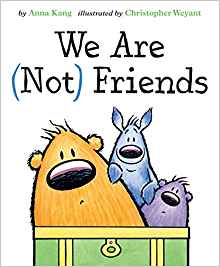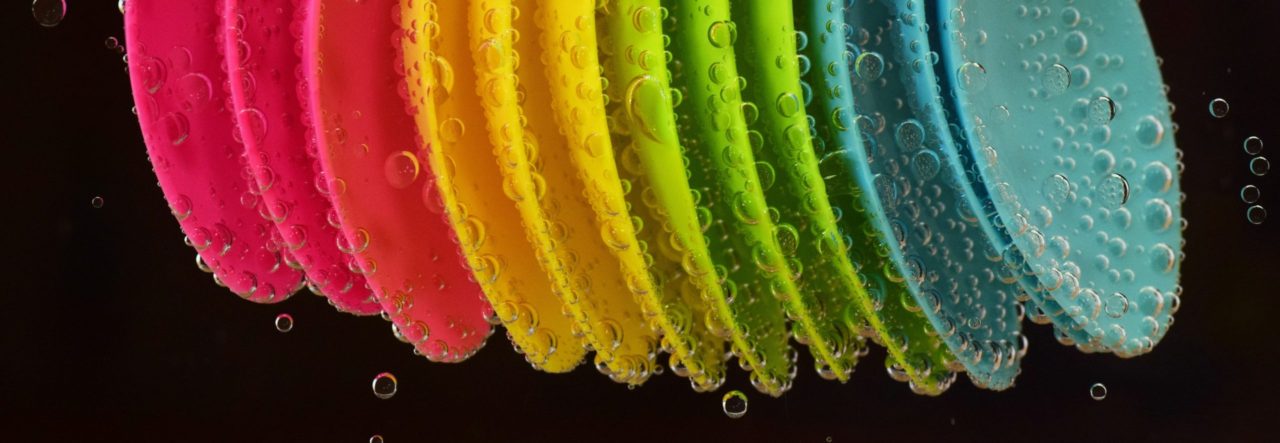
We Are (Not) Friends
Author: Anna Kang
Illustrator: Christopher Weyant
Two Lions
1 April 2019
40 pages
This month’s PB review is by Ryan G. Van Cleave (#1 Friend at Only Picture Books) and Ringling College of Art and Design Illustration Professor (and OPB superfriend) John Herzog.
–Ryan’s Review of the Writing–
We Are (Not) Friends is the fourth book in the You Are (Not) Small series, and the same fuzzy pals we’ve come to know from the other titles are here again with a new problem. The two of them are engaged in a terrific playdate with a cool trunk of fun stuff, and suddenly a new (blue) pal arrives, asking: “Can I play with you?”
Big brown fuzzy pal: “Yes!”
Little purple fuzzy pal: “Well…”
See where this is going? Welcome to the world of playdate–and friendship–politics. So many of the fun things this new trio of “friends” wants to try are best suited for two, such as a dancing duet. What’s the left-out fellow to do when the other two are having fun without them? Whether it’s playing at being dinosaur hunters or pretending to build a car, someone is on the outs each time.
The sparse text doesn’t get in the way of telling an important, vital story that showcases how friends–old and new–can get along if the idea of what friendship means is re-examined and re-imagined. Part of the fun, as well, is the delightful sound effects such as WHUMP, ERGG, OOPH, and BONK that dovetail with Weyant’s comedic visuals.
While I’m still a bit more taken by You Are (Not) Small, this latest book is a worthy addition to the series and will likely please many readers, big AND small alike. Adult readers, in particular, will appreciate the lesson on friendship and inclusion.
4.25 out of 5 pencils
–John’s Review of the Illustrations–
Friendship and empathy are at the heart of Anna Kang and Christopher Weyant’s endearing We Are (Not) Friends, which tells the story of three friends who each feel left out at some point or another during their playdate.
The story is simple, and the illustrations complement that simplicity well. Like the previous books in the series, this is very much a character study with minimal backgrounds and as-needed props. Instead of showing the characters against grand vistas and views, the illustrations are hyper-focused on these “fuzzy friends” trying to navigate the perils that can come with new friends.
An aspect of the characters that really stands out to me is their expressions. As an illustrator who admires and strives for simplicity, Weyant has achieved moments of humor, sadness, and depth with a mere handful of brush strokes. For me, looking at the effectiveness of these expressions is like watching Usain Bolt run the 100-meter dash or watching Gene Kelly dance while wearing roller skates. Weyant makes it look so darn easy when, in reality, nothing could be further from the truth. Simple is hard, and anyone who says differently is selling something.
My one nit-pick with the illustrations might be viewed as charming to others, but not to me. It doesn’t detract from the overall experience of the book, but I have to say… It drives me nuts that I don’t exactly know the species of these “fuzzy friends.” One looks like a bear, another looks like a kangaroo, and another looks like a gopher. But it’s never exactly clear WHAT these animals are supposed to be. That’s something I appreciate about the Elephant and Piggie books by Mo Willems. He’s very clear about the characters’ species. I’m willing to admit that I might be wrong on this, though. Maybe it actually is cute and charming that it’s left up to us what exactly the characters are in We Are (Not) Friends. Right now, however, I find myself craving some clarity.
I’ve gotta be honest here: I have a deep admiration for the talents of Anna Kang and Christopher Weyant. From a superficial standpoint, their books are fairly simple and straightforward–great for children. But, if you dig deeper (or you’re a parent who ends up reading these books three or four million times to your children at night), you can find an incredible amount of subtext that speaks volumes about the human condition–which is both amazing and amusing since their books have yet to feature a human character.
4 out of 5 crayons
![]() John Herzog is an illustrator and educator. His clients include Hasbro, Dreamworks TV, Houghton Mifflin Harcourt, and Highlights for Children. He also teaches illustration classes at Ringling College of Art and Design. John is a member of the Society of Illustrators and SCBWI, and received the 2018 SCBWI Magazine Merit Award for his Highlights High Five cover illustration. He lives in Florida with his wife, two kids, a tarantula, a bearded dragon, and a fish.
John Herzog is an illustrator and educator. His clients include Hasbro, Dreamworks TV, Houghton Mifflin Harcourt, and Highlights for Children. He also teaches illustration classes at Ringling College of Art and Design. John is a member of the Society of Illustrators and SCBWI, and received the 2018 SCBWI Magazine Merit Award for his Highlights High Five cover illustration. He lives in Florida with his wife, two kids, a tarantula, a bearded dragon, and a fish.

